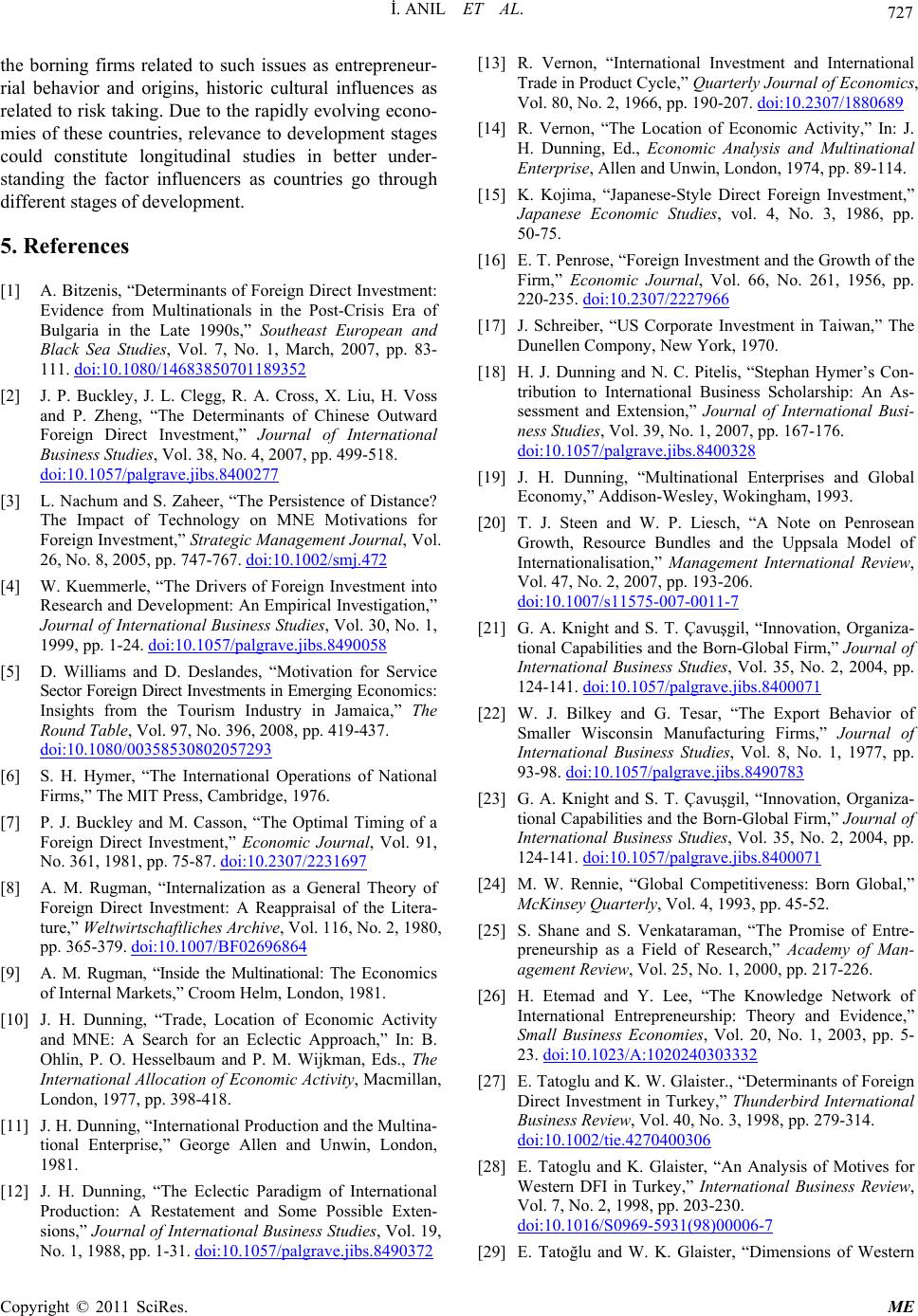
727
İ. ANIL ET AL.
the borning firms related to such issues as entrepreneur-
rial behavior and origins, historic cultural influences as
related to risk taking. Due to the rapidly evolving econo-
mies of these countries, relevance to development stages
could constitute longitudinal studies in better under-
standing the factor influencers as countries go through
different stages of development.
5. References
[1] A. Bitzenis, “Determinants of Foreign Direct Investment:
Evidence from Multinationals in the Post-Crisis Era of
Bulgaria in the Late 1990s,” Southeast European and
Black Sea Studies, Vol. 7, No. 1, March, 2007, pp. 83-
111. doi:10.1080/14683850701189352
[2] J. P. Buckley, J. L. Clegg, R. A. Cross, X. Liu, H. Voss
and P. Zheng, “The Determinants of Chinese Outward
Foreign Direct Investment,” Journal of International
Business Studies, Vol. 38, No. 4, 2007, pp. 499-518.
doi:10.1057/palgrave.jibs.8400277
[3] L. Nachum and S. Zaheer, “The Persistence of Distance?
The Impact of Technology on MNE Motivations for
Foreign Investment,” Strategic Management Journal, Vol.
26, No. 8, 2005, pp. 747-767. doi:10.1002/smj.472
[4] W. Kuemmerle, “The Drivers of Foreign Investment into
Research and Development: An Empirical Investigation,”
Journal of International Business Studies, Vol. 30, No. 1,
1999, pp. 1-24. doi:10.1057/palgrave.jibs.8490058
[5] D. Williams and D. Deslandes, “Motivation for Service
Sector Foreign Direct Investments in Emerging Economics:
Insights from the Tourism Industry in Jamaica,” The
Round Table, Vol. 97, No. 396, 2008, pp. 419-437.
doi:10.1080/00358530802057293
[6] S. H. Hymer, “The International Operations of National
Firms,” The MIT Press, Cambridge, 1976.
[7] P. J. Buckley and M. Casson, “The Optimal Timing of a
Foreign Direct Investment,” Economic Journal, Vol. 91,
No. 361, 1981, pp. 75-87. doi:10.2307/2231697
[8] A. M. Rugman, “Internalization as a General Theory of
Foreign Direct Investment: A Reappraisal of the Litera-
ture,” Weltwirtschaftliches Archive, Vol. 116, No. 2, 1980,
pp. 365-379. doi:10.1007/BF02696864
[9] A. M. Rugman, “Inside the Multinational: The Economics
of Internal Markets,” Croom Helm, London, 1981.
[10] J. H. Dunning, “Trade, Location of Economic Activity
and MNE: A Search for an Eclectic Approach,” In: B.
Ohlin, P. O. Hesselbaum and P. M. Wijkman, Eds., The
International Allocation of Economic Activity, Macmillan,
London, 1977, pp. 398-418.
[11] J. H. Dunning, “International Production and the Multina-
tional Enterprise,” George Allen and Unwin, London,
1981.
[12] J. H. Dunning, “The Eclectic Paradigm of International
Production: A Restatement and Some Possible Exten-
sions,” Journal of International Business Studies, Vol. 19,
No. 1, 1988, pp. 1-31. doi:10.1057/palgrave.jibs.8490372
[13] R. Vernon, “International Investment and International
Trade in Product Cycle,” Quarterly Journal of Economics,
Vol. 80, No. 2, 1966, pp. 190-207. doi:10.2307/1880689
[14] R. Vernon, “The Location of Economic Activity,” In: J.
H. Dunning, Ed., Economic Analysis and Multinational
Enterprise, Allen and Unwin, London, 1974, pp. 89-114.
[15] K. Kojima, “Japanese-Style Direct Foreign Investment,”
Japanese Economic Studies, vol. 4, No. 3, 1986, pp.
50-75.
[16] E. T. Penrose, “Foreign Investment and the Growth of the
Firm,” Economic Journal, Vol. 66, No. 261, 1956, pp.
220-235. doi:10.2307/2227966
[17] J. Schreiber, “US Corporate Investment in Taiwan,” The
Dunellen Compony, New York, 1970.
[18] H. J. Dunning and N. C. Pitelis, “Stephan Hymer’s Con-
tribution to International Business Scholarship: An As-
sessment and Extension,” Journal of International Busi-
ness Studies, Vol. 39, No. 1, 2007, pp. 167-176.
doi:10.1057/palgrave.jibs.8400328
[19] J. H. Dunning, “Multinational Enterprises and Global
Economy,” Addison-Wesley, Wokingham, 1993.
[20] T. J. Steen and W. P. Liesch, “A Note on Penrosean
Growth, Resource Bundles and the Uppsala Model of
Internationalisation,” Management International Review,
Vol. 47, No. 2, 2007, pp. 193-206.
doi:10.1007/s11575-007-0011-7
[21] G. A. Knight and S. T. Çavuşgil, “Innovation, Organiza-
tional Capabilities and the Born-Global Firm,” Journal of
International Business Studies, Vol. 35, No. 2, 2004, pp.
124-141. doi:10.1057/palgrave.jibs.8400071
[22] W. J. Bilkey and G. Tesar, “The Export Behavior of
Smaller Wisconsin Manufacturing Firms,” Journal of
International Business Studies, Vol. 8, No. 1, 1977, pp.
93-98. doi:10.1057/palgrave.jibs.8490783
[23] G. A. Knight and S. T. Çavuşgil, “Innovation, Organiza-
tional Capabilities and the Born-Global Firm,” Journal of
International Business Studies, Vol. 35, No. 2, 2004, pp.
124-141. doi:10.1057/palgrave.jibs.8400071
[24] M. W. Rennie, “Global Competitiveness: Born Global,”
McKinsey Quarterly, Vol. 4, 1993, pp. 45-52.
[25] S. Shane and S. Venkataraman, “The Promise of Entre-
preneurship as a Field of Research,” Academy of Man-
agement Review, Vol. 25, No. 1, 2000, pp. 217-226.
[26] H. Etemad and Y. Lee, “The Knowledge Network of
International Entrepreneurship: Theory and Evidence,”
Small Business Economies, Vol. 20, No. 1, 2003, pp. 5-
23. doi:10.1023/A:1020240303332
[27] E. Tatoglu and K. W. Glaister., “Determinants of Foreign
Direct Investment in Turkey,” Thunderbird International
Business Review, Vol. 40, No. 3, 1998, pp. 279-314.
doi:10.1002/tie.4270400306
[28] E. Tatoglu and K. Glaister, “An Analysis of Motives for
Western DFI in Turkey,” International Business Review,
Vol. 7, No. 2, 1998, pp. 203-230.
doi:10.1016/S0969-5931(98)00006-7
[29] E. Tatoğlu and W. K. Glaister, “Dimensions of Western
Copyright © 2011 SciRes. ME